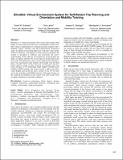BlindAid: Virtual Environment System For Self-Reliant Trip Planning And Orientation And Mobility Training
Author(s)
Schloerb, David W.; Lahav, Orly; Desloge, Joseph G.; Srinivasan, Mandayam A.
DownloadSchloerb-2010-BlindAid Virtual environment system for self-reliant trip planning and orientation and mobility training.pdf (701.4Kb)
PUBLISHER_POLICY
Publisher Policy
Article is made available in accordance with the publisher's policy and may be subject to US copyright law. Please refer to the publisher's site for terms of use.
Terms of use
Metadata
Show full item recordAbstract
BlindAid is a virtual environment (VE) system that enables blind people to more easily learn about new environments on their own. The system is implemented on a desktop personal computer with a Phantom® haptic interface and three-dimensional spatialized audio. In addition to providing blind users with non-visual stimuli similar to what they will depend on in the actual environment, the system is designed to enhance and accelerate the user's understanding of the unknown environment by giving him/her the ability to interact with the VE in ways that are not possible in the real world. The BlindAid system was developed and evaluated as part of an experimental study related to how people who are blind build cognitive maps of their physical environment and how recent advances in VE technology might support orientation and mobility (O&M) training. The current system is able to provide a visual display and record the user's actions in the VE for later review by researchers and O&M instructors. The paper focuses on the technical development of the system with some results from an initial evaluation by four blind volunteers.
Date issued
2010-04Department
Massachusetts Institute of Technology. Department of Mechanical Engineering; Massachusetts Institute of Technology. Laboratory for Human and Machine Haptics; Massachusetts Institute of Technology. Research Laboratory of ElectronicsJournal
2010 IEEE Haptics Symposium
Publisher
Institute of Electrical and Electronics Engineers
Citation
Schloerb, D.W. et al. “BlindAid: Virtual Environment System for Self-reliant Trip Planning and Orientation and Mobility Training.” Haptics Symposium, 25-26 March, Waltham, Massachusetts, USA 2010 IEEE. 2010. 363-370. © 2010 IEEE.
Version: Final published version
Other identifiers
INSPEC Accession Number: 11230000
ISBN
978-1-4244-6820-1